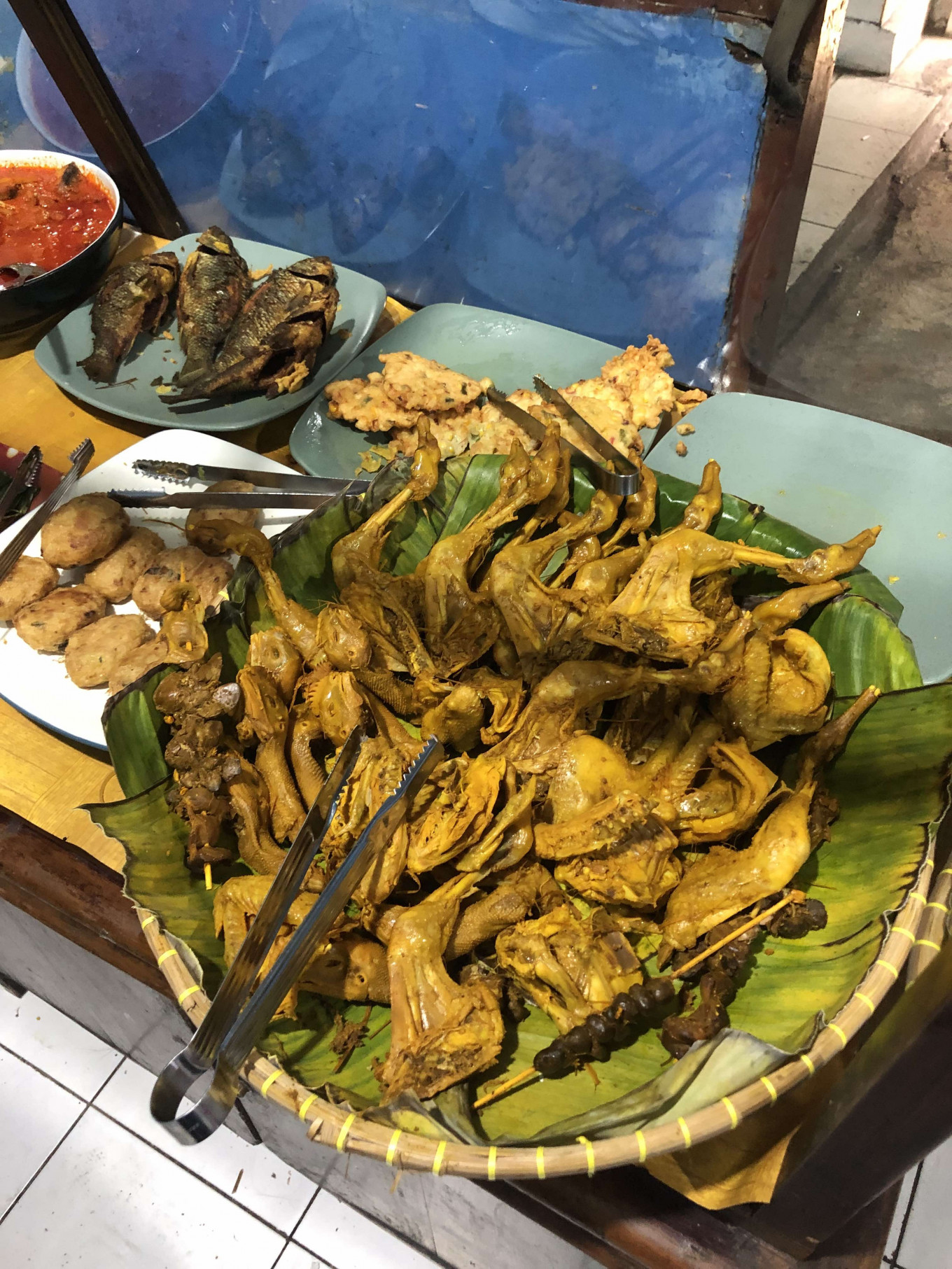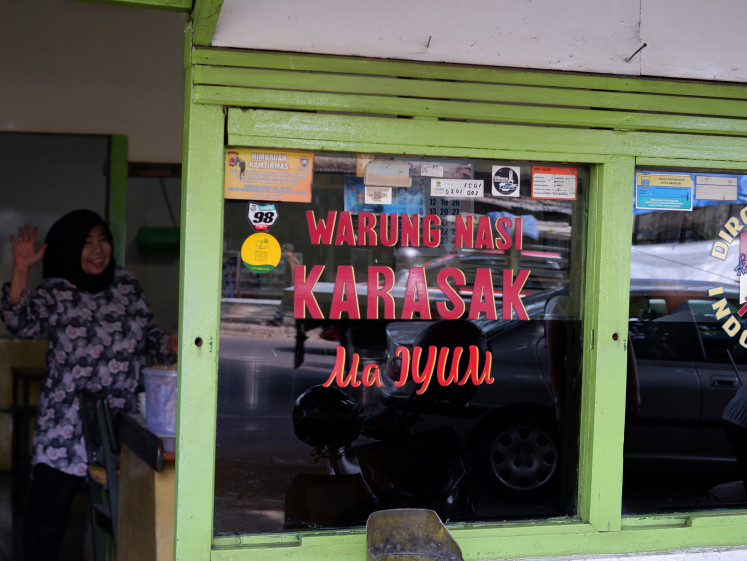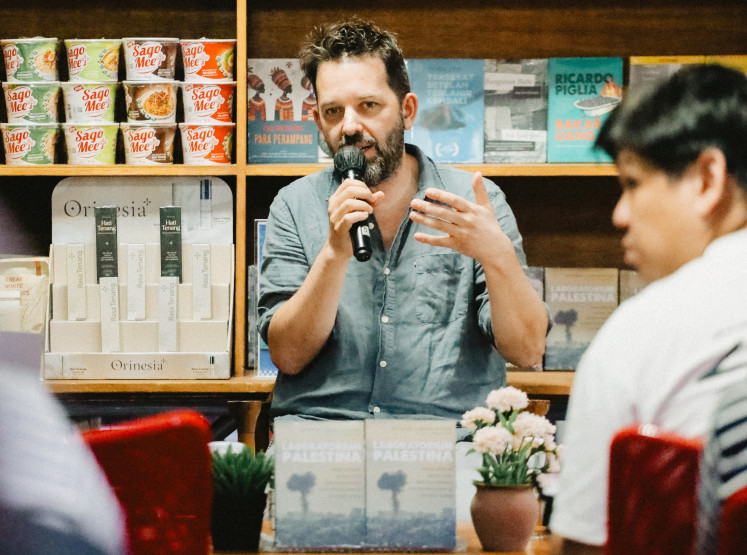Popular Reads
Top Results
Can't find what you're looking for?
View all search resultsPopular Reads
Top Results
Can't find what you're looking for?
View all search resultsFive authentic Sundanese eateries in Bandung
Change text size
Gift Premium Articles
to Anyone
I
n pursuit of Sundanese delicacies: From the corners of traditional markets in Cihapit and Palasari, to the busy streets of Pasirkoja and Moh. Toha.
Looking past the more widely known Sundanese eateries of Bandung, The Jakarta Post has compiled a diverse list of warung nasi (food stalls serving rice) and restaurants, ranging from the historical – dating back to the late ‘40s and ‘80s – to the newer, post-franchise, mid-noughties generation.
Warung Nasi Karasak Ma Iyum
Jl. Moh. Toha 250, Karasak, Astanaanyar, Bandung
Comfortably perched at a junction on one of Bandung’s most-frenzied roads and trucking routes, Jl. Moh. Toha, Warung Nasi Karasak Ma Iyum’s roots can be traced back to the 1980s, when its current parking attendant, Agus, dined there as a young man.
“Either babat [tripe] or gulai sapi [beef curry],” said Agus as he tipped back the brim of his cap. He was naming his then-favorites off the warung’s list of dishes, which he sadly needs to cut back on.
Along with the previously mentioned dishes, WN Karasak Ma Iyum’s more umami-leaning, cut-against-the-grain version of gepuk (Sundanese meat dish) is the third prong of the shop’s own engrained style of Sundanese cuisine that bears resemblance to the spice-heavy Padang cuisine – considering as well its penchant for offal.
Dishes served on stainless steel trays lined the tiered, almost U-shaped table. Etty, the shop’s attendant, who at times switched with fellow attendant Kokom, sat firmly in the middle as she took orders, served food and operated as a cashier.
A welcoming face: Etty (left), one of the stall's current attendants, poses at Warung Nasi Karasak Ma Iyum. (JP/Anindito Ariwandono) (JP/Anindito Ariwandono)There were rumors regarding the origins of the shop’s seating configuration, such as how, aside from being an efficient setup, it was designed that way initially to highlight Ma (Sundanese title for mother) Iyum’s presence as the figure of the shop.
Taking most of the dishes there with scalding yet refreshing karedok leunca (mashed black nightshade raw salad) as a side – which Kokom mashes with only a single cengek domba (datil pepper) for a “milder” taste – and a large helping of lalapan (Sundanese raw vegetable salad) comes highly recommended.
Warung Nasi Mang Aja Thea
Pasar Buku Palasari, Jl. Palasari No.135, Malabar, Lengkong, Bandung
For most people, Palasari Secondhand Book Market in Bandung might seem like an unlikely place to look for a Sundaan – a term used for almost everything done in an authentic Sundanese way – eating spot. Yet the lunchtime The Jakarta Post was there, civil servants, clad in khakis and armed with a purpose, had started flocking into the market. They were headed to Warung Nasi Mang Aja Thea, a small restaurant tucked behind the market’s second layer of book stalls.
By the time the lunch break had ended, the warung had run out of its most sought-after dishes. Clumps of bakwan udang (prawn fritters) peeked out of a takeaway bag along with other neatly packed dishes, safely stored away from the customers’ jostling during peak time.
“It’s already paid for,” said Imas while smiling, referring to the bagged bakwan udang a customer had been eyeing. Her hands were yellow from handling spices—some might consider this a seal of quality.
“This place is still pretty much like what I remember from back when I was a child,” Imas said as she pointed toward the shop’s glossy brown-painted sills.
Although the plates serving karedok leunca, asakan (blanched vegetables) and ikan asin (salted fish) were nearly spotless and waiting for a refill, some of the main pillars of the restaurant still remained: there were various cuts of ungkep chicken, corn fritters, pepes usus (intestines steamed in banana leaves), fried nila (tilapia) fish and cuttlefish skewers – the savoriness of the chicken was quite beyond expectations.
WN Mang Aja Thea arguably hails from a more authentic style of Sundanese cuisine.
Warung Nasi Bu Eha
Pasar Cihapit, Jl. Cihapit No.8A, Cihapit, Bandung
In the midst of the now-gentrified Cihapit quarter, Eha has been running her shop, Warung Nasi Ibu Eha, since 1949 – during the second Politionele Acties military offensive undertaken by the Netherlands in Java and Sumatra.
The shop, which was founded in 1947 by Eha’s mother (predating even Warung Nasi Ampera and Warung Makan Ponyo, founded in the 1960s and 1970s respectively) has seen its fair share of clientele, ranging from penniless students to historic figures of the nation.
The shop initially mixed in western choices such as biefstuk (Dutch beef steak), among other dishes, during its early days—considering that they had Dutch nationals eat there from time to time – but the general selection of Sundanese dishes has remained basically the same.
Eha, although not directly handling the cooking herself anymore, still oversees everything that happens in the shop’s kitchen, ultimately acting as the gatekeeper of the shop’s authenticity.
Warung Nasi Bu Eha’s version of gepuk fits a better-known construction of the traditional Sundanese dish: the meat is cut along the grain and its taste leans more toward its sweetness. Barely into the afternoon, the shop runs out completely of the favorites, gepuk, bakwan udang and Eha’s rendition of perkedel kentang (potato fritters)—all deemed worthy of going into battle for — even the leftover crumbs and the gepuk’s grated coconut relish (people still take them as sides).
Ask for a tray of lalapan and sambal, and you will be handed a tray of blanched greens, or asakan (a mix of papaya, cassava and taro leaves with baby cabbage) instead of its raw counterpart atahan, and a helping of sambal terasi (shrimp paste sambal).
Rumah Makan Mang Akub
Jl. Terusan Pasirkoja No.151, Jamika, Bojongloa Kaler, Bandung
Previously one of the better branches of Rumah Makan Manjabal located in Pasirkoja, Rumah Makan Mang Akub is well into its third month after its transformation into its newer Sundanese restaurant franchise (RM Manjabal was first introduced in 2003 in Bandung). The restaurant had been left to its own devices when the Post visited on Aug. 11.
Unlike the previous branches, Rumah Makan Mang Akub is a more “refined” Sundanese restaurant that comes with typical Sundanese ornaments and features (although its merging with the building’s original decor can be a bit unnerving). It features, for instance, a bamboo lesehan (matted floor) area where customers can sit cross-legged, and the sambal served on stone mortars—its freshness was quite the highlight.
Beaned grains: 'Nasi tutug oncom' at Rumah Makan Mang Akub is one of the recommended alternatives to plain white rice, as well as 'nasi liwet' for a more adventurous mood. (JP/Anindito Ariwandono) (JP/Anindito Ariwandono)The restaurant, still trying to keep the general quality the same as its Manjabal franchise days, offers a tried and tested set of authentic Sundanese cuisine. The gourami dishes (grilled, fried or in a soup) are a must-try, along with the more obvious choices like ungkep chicken, salted fish and gepuk.
Up the ante by pairing them with nasi tutug oncom (rice mixed with oncom fermented beans) or nasi liwet (rice cooked in coconut milk and spices) and a large mortar of sambal dadak if you are feeling a bit adventurous.
Warung Dalaraos
Jl. Siliwangi No.43, Cipaganti, Coblong, Bandung
Starting off as a Sundanese home-cooked catering outfit on Jl. Siliwangi, Warung Dalaraos comes in at a more liberal level of Sundanese cuisine, even novel, at times – considering the wide variety of dishes it serves. Yet the mainstays, such as the ungkep chicken, gepuk and its various pepes dishes are well on the authentic side.
Compared with the previously mentioned food stalls and restaurant, its historic background might seem a little lacking and its two-story modern shophouse facade is far removed from the visual cues and identities of Sundanese restaurants – the second floor’s dining area looks more like a modern-day, self-service canteen.
However, there is no doubt that Warung Dalaraos stands on firm ground in regards to its understanding of Sundanese cuisine.













